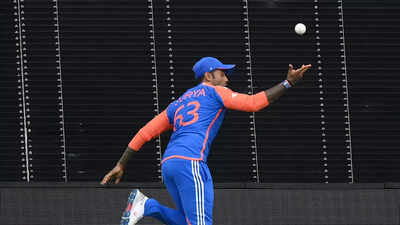The International Cricket Council (ICC) has rolled out significant updates to the playing conditions across Test, ODI, and T20I formats. These changes impact various aspects of the game, including over rates, ball usage, boundary catches, concussion protocols, and the adjudication of wide balls.

To combat slow over rates and reduce match delays, the stop clock rule, previously tested in white-ball cricket, is now a permanent fixture in Test matches. A fielding team must commence a new over within 60 seconds of completing the previous one. Teams will be issued two warnings per innings, with subsequent breaches incurring a five-run penalty. These warnings are reset every 80 overs, coinciding with the availability of a new ball.
In One Day Internationals (ODIs), the use of two balls will now be restricted to the first 34 overs. For the remaining 16 overs, the fielding side will have the option to select one of the two balls to continue play. This adjustment aims to better manage the wear and tear of the ball.
A significant change has been made to the rules governing boundary catches. Fielders making airborne contact with the ball beyond the boundary rope must now land completely within the field of play to complete a legal catch. Should they step outside the boundary and jump again, they are permitted only one additional touch before landing inside the boundary.
The ICC has strengthened its protocols regarding concussions. Teams are now required to pre-nominate concussion substitutes. Any player diagnosed with a concussion will be subject to a mandatory seven-day rest period before being cleared to return to competitive play.
A trial of a new wide ball rule is set to take place in white-ball cricket. The batter's position at the point of delivery, rather than after any subsequent movement, will serve as the reference point for adjudicating wides. Deliveries passing between the leg stump and the extended protected area marker at the popping crease will no longer be called wide. However, deliveries passing behind the batter's legs may still be deemed wide.
To aid umpires in making these judgments, the protected area marker will be extended to the popping crease, providing a clear visual guide.
The Decision Review System (DRS) will now utilize the actual physical outline of the stumps and bails to define the wicket zone, leading to greater precision in Leg Before Wicket (LBW) decisions.
In addition to the existing five-run penalty for a deliberate short run, the fielding team will now have the right to choose which batter takes strike for the next delivery.
In domestic first-class cricket, a significant on-field injury sustained by a player at any point after the match has commenced (including during warm-ups) will allow for that player to be replaced by a like-for-like player for the duration of the game.
The new Test playing conditions were effective as of the Sri Lanka vs Bangladesh Test on June 17. The revised ODI and T20I rules will be implemented starting with the same series, beginning with the first ODI on July 2 and the T20Is from July 10. All international matches played after these dates will adhere to the updated regulations.
Newer articles
Older articles
 5 Overlooked Warning Signs of Colon Cancer: Early Detection Saves Lives
5 Overlooked Warning Signs of Colon Cancer: Early Detection Saves Lives
 Shukla's ISS Arrival Heralds New Era for Indian Space Exploration; Gaganyaan Mission Looms
Shukla's ISS Arrival Heralds New Era for Indian Space Exploration; Gaganyaan Mission Looms
 Vijay Sethupathi Apologizes Amid Controversy Over Son Surya's Film 'Phoenix'; Thalapathy Vijay's Support Revealed
Vijay Sethupathi Apologizes Amid Controversy Over Son Surya's Film 'Phoenix'; Thalapathy Vijay's Support Revealed
 Android Security Alert: Government Warns of Critical Flaws Exposing User Data
Android Security Alert: Government Warns of Critical Flaws Exposing User Data
 Skin Deep: 7 Warning Signs on Your Skin That Could Signal Heart Trouble
Skin Deep: 7 Warning Signs on Your Skin That Could Signal Heart Trouble
 Ashada Gupt Navratri 2025: Dates, Significance, and How to Observe This Hidden Festival
Ashada Gupt Navratri 2025: Dates, Significance, and How to Observe This Hidden Festival
 Smith Eyes Grenada Test Return After Injury Layoff
Smith Eyes Grenada Test Return After Injury Layoff
 Staying Hydrated May Significantly Lower Risk of Heart Failure, New Study Suggests
Staying Hydrated May Significantly Lower Risk of Heart Failure, New Study Suggests
 Moto G54 Price Slashed in India: Check Out the New, Lowered Costs
Moto G54 Price Slashed in India: Check Out the New, Lowered Costs
 Gambhir Sidelines Pant's Twin Tons After India's Test Loss, Emphasizes Team Performance
Gambhir Sidelines Pant's Twin Tons After India's Test Loss, Emphasizes Team Performance